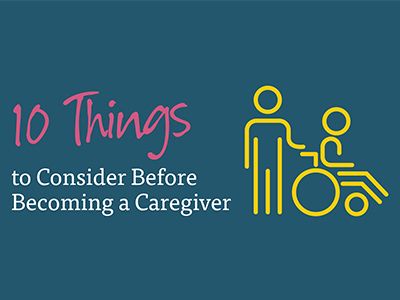Maybe it was an in-home accident that left your parent requiring long-term care. Or a form of dementia your grandparent suffers from that keeps worsening. Whatever the case, you and your loved one have decided it’s time for him or her to move into a place that offers skilled care and focused treatment. To help guide you toward an arrangement you both feel confident about and comfortable with, consider the following steps.
1. Learn how to talk to your loved one about moving into a care facility.
To help your loved one find the right kind of place to live, you’ll need to ask questions to learn more about his or her personal preferences for things like meals, types of care, degree of social interaction or a religious or community connection. Also, you’ll need to make a realistic assessment of what level of daily care and medical treatment will be needed. Speak to you loved one’s attending physician, therapist or counselor to get more information.
Involve loved ones early in the discussion to help you make the decision with them, not for them. This will also help you avoid hastily made arrangements for care because your options became limited or because of a rapidly worsening condition, which could only make the situation more stressful.
2. Find out what are the different types of care facilities.
A major factor in your decision will be determining which type of care facility will best serve your loved one’s needs — and what’s available at the time he or she will need to move. You’ll have a range of different living arrangements and care facilities to choose from, including:
- Retirement community: A residential community or housing complex designed for older adults who enjoy living on their own, where activities and opportunities for social interaction are usually provided.
- Continuous care retirement community: A retirement community with facilities and accommodations for independent living, assisted living and nursing home care, offering residents a range of care. A person can move between levels of care as needed.
- Independent living: An arrangement designed for individuals who can still live on their own and perform daily activities such as cooking or laundry but want access to things like dining and medical care when needed.
- Assisted living: A great option for individuals who have difficulty with daily activities at home. They can continue to live an independent lifestyle but also receive regular assistance for a range of daily activities ranging from cleaning to meal preparation.
- Nursing home/skilled nursing facility: While these two terms are often used interchangeably, there are generally noticeable differences between skilled nursing and nursing home care, such as:
| Skilled Nursing Facility | Nursing Home |
|---|---|
| Usually serves as a temporary residence, like a short-term rehabilitation | Permanent residence for those who can’t live on their own |
| Skilled nursing care administered by trained medical professionals, such as a registered nurse or licensed practical nurse | Ongoing care, also known as custodial care, is conducted by a person with less medical training, such as a certified nursing assistant or a non-medical professional |
| Costs covered by Medicare for a short period of time | Long-term care costs are not usually covered by Medicare. Most, but not all, nursing homes accept Medicaid payment depending on financial situation. |
| Regulated in large part by the U.S. Department of Health and Human Services | Regulation varies by state health agencies |
3. Know what to look for on a care facility visit.
Conduct your visits early in the process, while your loved one is physically able and alert. This will help you gather more information to make an informed decision. As part of your visit:
- Arrange to meet with the facility director or manager.
- Ask questions of staff members and talk with residents, if possible.
- Check out the cleanliness and physical condition of the facility, and take into account all that you see, hear and smell.
Use this checklist to help you organize your thoughts and findings, which will come in handy as you start to compare facilities.
4. Discover the costs of long-term care.
It’s no secret that long-term care costs are expensive. So it’s good to take a proactive approach to determine how a combination of private savings, insurance or government assistance can be used to help pay for the ongoing costs. Here are some potential sources to pay for the care your loved one:
- Long-term care insurance
- Life insurance (with some policies)
- Long-term care veterans assistance for veterans/surviving spouses
- Personal, or “out-of-pocket” funds, such as personal savings, investments or retirement accounts
- Proceeds from the sale of home or other assets
- Social Security benefits
- Medicare
- Medicaid
Based on the facility you choose, the type of care your loved one needs and his or her financial situation, he or she may not be eligible receive Medicare or Medicaid.
When it comes to planning for the financial aspects of long-term care, note there are both public agencies and private organizations that offer assistance at no charge. Start by contacting your local Area Agency on Aging (AAA) office. In addition, there are private advisors that charge hourly or project fees for their assistance.
5. Seek professional advice and assistance regarding your loved one's care.
Another important part of the move to a long-term care facility is making sure your loved one has the necessary legal documents that make up an estate plan. For example, does your loved one:
- Have a completed financial (or durable) power of attorney? This document enables you (or whoever your loved one names) to manage any expenses if he or she is not able to make financial decisions independently.
- Have any current legal documents in place, such as a living will? This helps ensure your loved one receives the type of end-of life care and treatment he or she wishes.
- Have a will? This essential legal document allows your loved one to determine the people who will get their property, personal belongings and other assets, which is additional measure of peace of mind for both of you.
You and your loved one should also work with an attorney who is knowledgeable of estate planning and elder law issues. The attorney can:
- Help complete the necessary legal documents to ensure everything is in order and your loved one’s wishes are carried out in the appropriate manner.
- Explain how Social Security benefits and Veterans benefits apply to long-term care scenarios.
- Determine actions you need to take and requirements to legally qualify for Medicaid and other government benefits.
There are also organizations, such as the National Council on Aging, who can provide resources and contacts for elder care advocates, who address eldercare-related questions, assess eldercare needs, help develop a care plan and conduct searches for living and care facilities.
6. Be an advocate for a loved one.
With all the different financial, legal, logistical and emotional elements at play, searching for the right care facility for your loved one can be a time-consuming, frustrating process. But it’s also an opportunity to advocate on his or her behalf to ensure the right kind of care is provided. That will go a long way in helping him or her move on to the next chapter in life with confidence, comfort and dignity.



